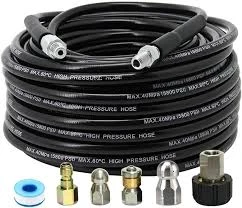How to Properly Use and Maintain R134a Charging Hoses for Refrigerant Systems
Understanding the R-134a Charging Hose A Comprehensive Guide
When it comes to maintaining your vehicle’s air conditioning system, understanding the tools involved is crucial. One such tool is the R-134a charging hose. This essential component plays a key role in refrigerant management, ensuring your AC system operates efficiently. In this article, we will delve into the functionality, types, and best practices for using an R-134a charging hose.
What is R-134a?
R-134a, or tetrafluoroethane, is a common refrigerant used in automotive air conditioning systems. It replaced the older R-12 refrigerant due to its ozone-friendly properties. While R-134a has been a standard for many years, it’s essential to understand how to properly use and handle it to maintain both your vehicle's performance and environmental safety.
The Purpose of the Charging Hose
An R-134a charging hose is a specialized tool designed to connect the refrigerant canister to the vehicle’s AC system. Its primary purpose is to facilitate the transfer of refrigerant into the system. Equipped with specific fittings and gauges, these hoses enable technicians and vehicle owners to accurately charge the system and check pressures, ensuring optimal functionality.
Components of the Charging Hose
A typical R-134a charging hose consists of several key components
1. Hose Made from durable materials designed to withstand high pressure, the hose is typically marked with pressure ratings to ensure safe use.
2. Fittings The ends of the hose come with specific fittings. A low-pressure fitting connects to the low-pressure service port of the AC system, while the gauge end often attaches to a refrigerant canister.
3. Gauge Many charging hoses come with built-in pressure gauges that display the system's pressure. Monitoring this pressure is crucial for determining whether the system requires additional refrigerant or if there are underlying issues affecting performance.
4. Shut-off Valve Some hoses are equipped with a shut-off valve that allows users to stop the flow of refrigerant when needed, preventing leaks and spills.
134a charging hose

Types of Charging Hoses
Charging hoses come in various lengths and configurations to fit different needs
- Standard Hoses These are the most common type, suitable for general use. - Long Hoses Ideal for larger vehicles or when the refrigerant canister needs to be positioned at a distance from the AC system. - Dual Hoses These typically include both high-pressure and low-pressure hoses in one assembly, allowing for complete system servicing without the need for multiple tools.
Best Practices for Using an R-134a Charging Hose
1. Safety First Always wear safety goggles and gloves while handling refrigerants. R-134a can be harmful if inhaled or if it comes into contact with skin.
2. Check for Leaks Before attaching the hose, visually inspect it for any signs of wear or damage. A compromised hose can lead to refrigerant leaks.
3. Attach Properly Always connect the charging hose to the correct service port. Using the low-pressure port for R-134a is essential to prevent damage to the system.
4. Monitor Pressure Use the gauge to monitor system pressure during the charging process. This will help you avoid overcharging, which can cause serious damage to the compressor.
5. Follow Guidelines Make sure to follow the manufacturer’s guidelines for the specific vehicle model. Different systems may have unique requirements for refrigerant amounts and charging procedures.
6. Ventilate Work Area When working with refrigerants, ensure proper ventilation to avoid buildup of harmful gases.
Conclusion
The R-134a charging hose is a vital tool for anyone looking to maintain their vehicle’s air conditioning system. Understanding its components, types, and proper usage can help you effectively manage refrigerant levels, ensuring a cool and comfortable driving experience. As with any automotive maintenance task, taking the necessary precautions and following best practices is key to a successful outcome. Whether you’re a DIY enthusiast or a professional technician, mastering the use of an R-134a charging hose will serve you well in keeping your vehicle’s AC system running smoothly.
-
Ultimate Spiral Protection for Hoses & CablesNewsJun.26,2025
-
The Ultimate Quick-Connect Solutions for Every NeedNewsJun.26,2025
-
SAE J1401 Brake Hose: Reliable Choice for Safe BrakingNewsJun.26,2025
-
Reliable J2064 A/C Hoses for Real-World Cooling NeedsNewsJun.26,2025
-
Heavy-Duty Sewer Jetting Hoses Built to LastNewsJun.26,2025
-
Fix Power Steering Tube Leaks Fast – Durable & Affordable SolutionNewsJun.26,2025

